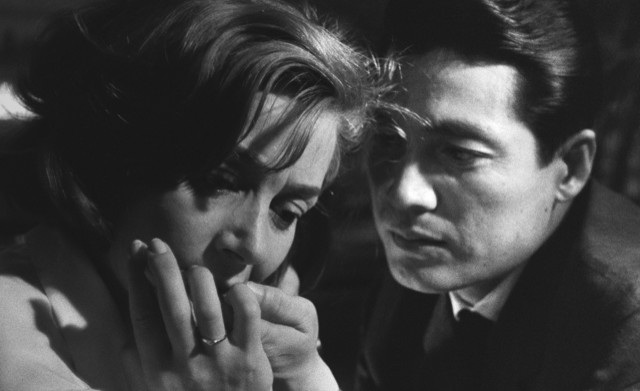Hiroshima mon amour is a 1959 romantic drama directed by Alain Renais and written by French novelist Marguerite Duras. The film stars Emmanuelle Riva (2012 Oscar nominee for Amour) and Eiji Okada (Woman in the Dunes, The Ugly American). This lyrical film belongs to an exciting era when a group of French filmmakers transformed and elevated film to a higher art form. In the late 50s in France, these auteurs rebelled against the Hollywood standard mode of production to create innovative films with a different narrative and aesthetic approach. What in cinema history is known as the French New Wave. Though Renais was part of the Left Bank, a parallel film movement, Hiroshima mon amour is considered a breakthrough film of the French New Wave.
Alain Renais, was sought after to make a documentary about the atomic bombing of Hiroshima. But Renais, who had recently made a documentary about World War II (Fog of War), wanted to do something different. A fictional film about remembrance and the representation of horror. He asked Marguerite Duras, a modernist writer, to write a love story set against the background of the aftermath of this horrific event. Through the telling of a deeply personal story and the use of avant-garde and modernist techniques, Renais and Duras evoke self-reflection on individual and collective memory. Along with the emotional unraveling of remembering trauma.
The film tells the story of two strangers who fall in love in Hiroshima, Japan, in the aftermath of the U.S. bombing of Hiroshima and Nagasaki in 1945. A Japanese architect “He” and “She,” a French actress working in a film about peace. Their love affair triggers her memories, forcing her to confront her past and loss of love. The story begins in a hotel room where “She” claims that she has seen Hiroshima.” In response “He” says, “You saw nothing in Hiroshima. Nothing.” “She” insists that she saw everything, but again “He” repeats the same phrase, alluding that after the bombing, it is not possible to see and feel the pain and destruction in Hiroshima.
Hiroshima mon amour is from a critical time in cinema history and the history of the world. From a social and political perspective, this film brilliantly represents the condition of man in modern society and the nuclear age. From an aesthetic perspective, Hiroshima mon amour shows Renais successful use of modernist and unconventional narrative techniques to express the abstract themes –the representation of horror, memory, and the imagined past– he explores in the film.
These techniques are present from the beginning of the film; Renais juxtaposes the lovemaking scenes of the couple in the hotel with abstract images of the destruction of Hiroshima. The empty and bare places where the couple interacts express the feeling of isolation of the characters. It is remarkable how Renais conveys the loneliness and anxiety of modern man/woman while avoiding being didactic and sentimental.
What makes this film so rich in terms of story is the artistic collaboration between Renais and Duras. Hiroshima Mon Amour evokes self-reflection from the part of the viewer by focusing on individual inner conflicts and personal relationships set against a hostile world. Hiroshima Mon Amour earned an Academy Award nomination for screenwriter Marguerite Duras and received the Fipresci International Critics’ award at the 1959 Cannes Film Festival. Due to its harrowing anti-nuclear stance, it did not participate in the main competition to avoid upsetting the U.S. However, the film became a canon in the history of film, and 60 plus years later, cinephiles all over the world are still enjoying this cinema art masterpiece.
